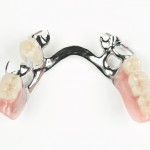
The shortened dental arch consisting of ten pairs of occluding anterior and premolar teeth is considered sufficient to provide good oral function and quality of life. However, restorative or prosthetic replacement to restore complete dental arches is often undertaken.
The aim of this study was to determine whether the daily functional needs and the quality of life of adult patients with a posterior reduced mandibular dental arch would be satisfied without having all their missing teeth replaced with a mandibular removable partial denture prosthesis (RPDP), as compared to having a prosthesis.
Methods
Patients with at least three and not more than six posterior occluding pairs of teeth were enrolled sequentially and randomised into one of two treatment groups: a denture or no-denture group. The primary outcomes were patient satisfaction, oral function and Oral Health Related Quality of Life (OHRQoL). Secondary outcomes were clinical performance, survival of remaining teeth and mandibular RPDP (caries, periodontal problems, loss of teeth or inability to wear the RPDP), or a change in treatment allocated. Outcome assessment were undertaken at 3 and 12 months. Analysis of data was performed in stages, adding samples of 10 incrementally, and stopping when the relevant statistical tests indicated a clear conclusion as judged by the power set at 80% or above. Statistical analysis was performed by the ‘intention-to-treat’ principle.
Results
- 50 patients were included, 25 per group
- The average age was 42.3 (range 23-55yrs). 78% were female.
- In the denture group 10% of the patients were not satisfied and 20% were unhappy with their function.
- For the no-denture group 85% of the patients (with 15% having left the study) were satisfied with both their function and their non-denture status.
Conclusions
The authors concluded: –
Patients with a mandibular posteriorly reduced dental arch reported greater satisfaction, perceived success of treatment relating to function and OHRQoL without a RPDP compared to those with a complete dental arch that was extended with a cobalt-chrome clasp-retained RPDP.
Comments
Originally this trial was planning to recruit a large number of patients (420) but recruitment challenges meant that they switched to a sequential sampling approach. Statistically a sample of 30 patients was deemed to be sufficiently powered but a pragmatic decision to recruit 50 patients was taken. Nine patients dropped out of the study with some leaving after being allocated to the ‘no-denture’ group. The authors highlight potential concerns regarding the sampling approach and the generalisability of this relatively small sample size.
The results of the study are in line with the findings of an earlier systematic review (Dental Elf – 16th Jun 2017) that included 3 studies and suggested a better oral health quality of life with a shortened dental arch.
Links
Primary paper
Khan S, Chikte UM, Omar R. Outcomes with a posterior reduced dental arch: a randomised controlled trial. J Oral Rehabil. 2017 Nov;44(11):870-878. doi: 10.1111/joor.12549. Epub 2017 Sep 4. PubMed PMID: 28799171.
Other references
Dental Elf – 16th Jun 2017
Shortened dental arch: impact on oral health-related quality of life

[…] The aim of this study was to determine whether the daily functional needs and the quality of life of adult patients with a posterior reduced mandibular dental arch would be satisfied without having all their missing teeth replaced with a mandibular removable partial denture prosthesis (RPDP), as compared to having a prosthesis. more […]